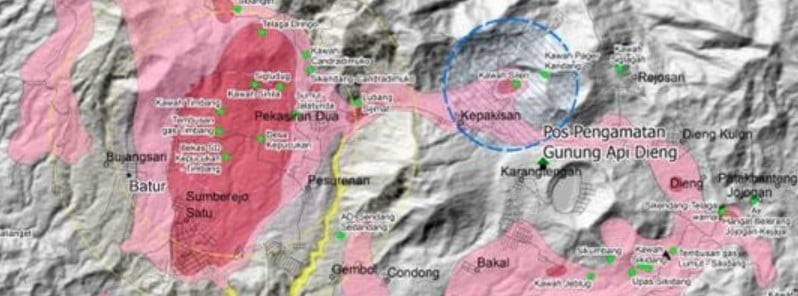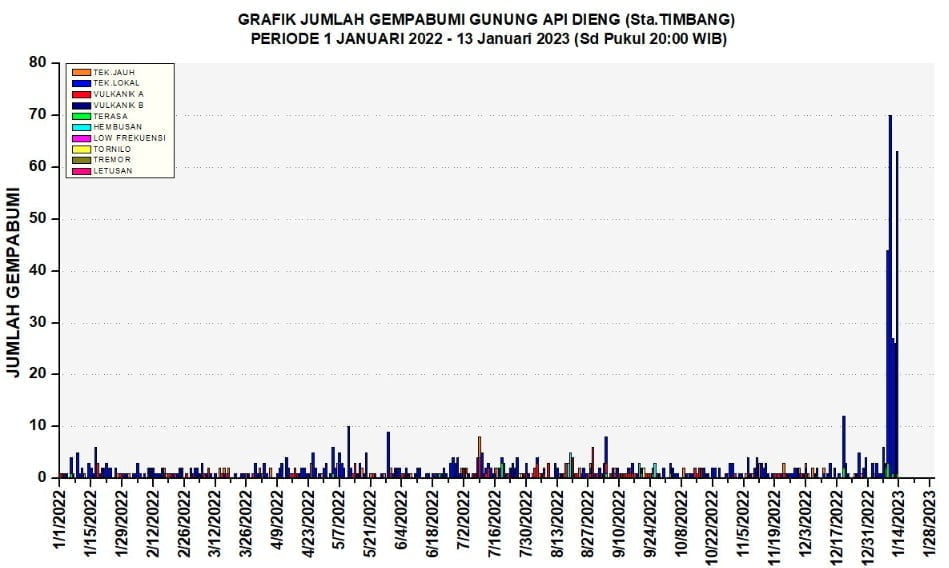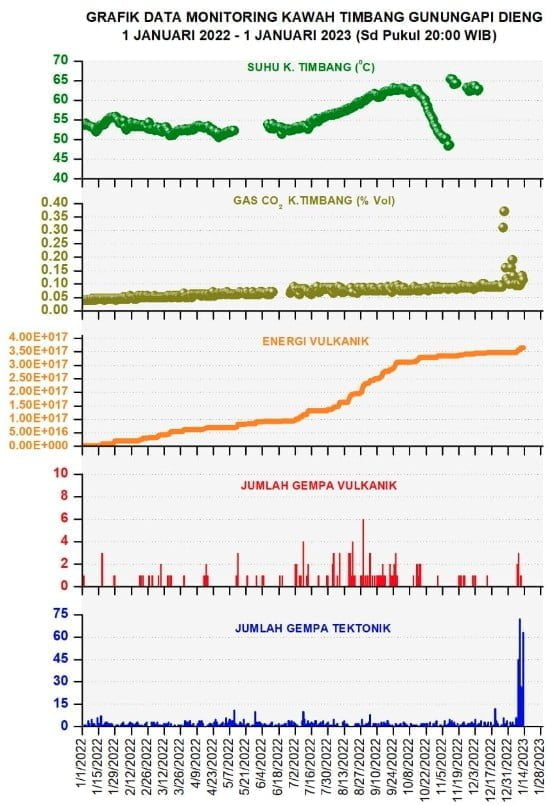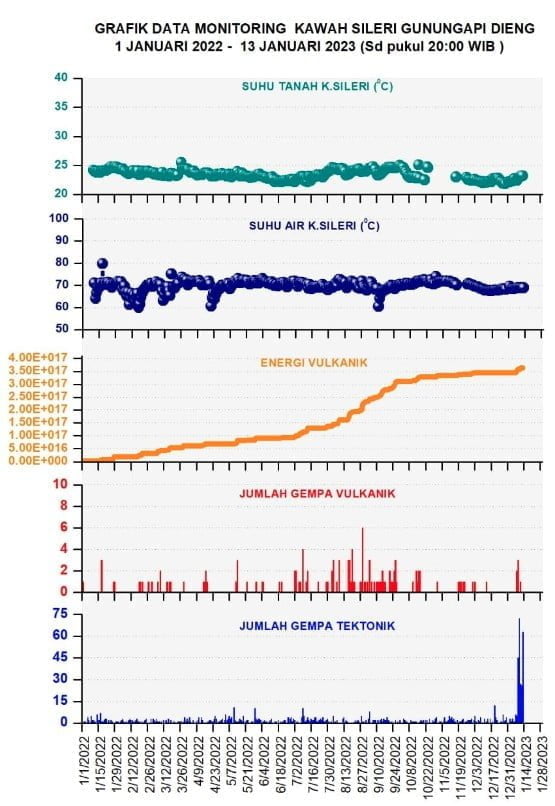Seismic unrest at Dieng volcano, Alert Level raised to Level 2, Indonesia

Observational data shows an increase in seismicity at Indonesia’s Dieng volcano, prompting the Indonesian Centre for Volcanology and Geological Hazard Mitigation (PVMBG) to raise the Alert Level from 1 to 2 (on a scale of 4) on January 13, 2023. The Dieng Volcanic Complex, which is made up of multiple stratovolcanoes and more than 20 small Pleistocene-to-Holocene craters, last erupted in April 2021 (VEI 1).
Based on visual and instrumental observations, there has been an increase in volcanic activity at Dieng volcano as indicated by an increase in the occurrence of deep volcanic earthquakes and local tectonic earthquakes since January 9, 2023. This could indicate “fractures” beneath the surface as a result of volcanic activity. Furthermore, results of CO2 gas measurements in Timbang Crater between January 1 and January 13, 2023, have tended to increase with an average between 0.09% and 0.11%.
The results of measuring the water temperature of Sileri Crater between January 1, 2023, and January 13, 2023, were between 68.5 – 68.6 °C (155.3 – 155.5 °F), and the soil temperature in Sileri Crater showed between 21.6 – 21.7 °C (70.9 – 71.1 °F), indicating relative stability.
The potential hazards that could arise due to the increased volcanic activity at Dieng include an increasing concentration of volcanic gases, particularly CO2 in Timbang Crater, which could be followed by the occurrence of CO2 gas flow, and phreatic eruptions in Sileri Crater in the form of mudflows or material ejection. These phreatic eruptions or mudflows can occur without being preceded by an increase in both visual and seismic activity.
Based on a thorough evaluation, the Activity Level at Dieng has been increased from Level I (Normal) to Level II (Alert) starting January 13, 2023, at 23:00 WIB (15:00 UTC) with recommendations adjusted to the latest potential threats.
With respect to the activity at Dieng in the Level II activity level (Alert), PVMBG recommends that the public and tourists do not approach Sileri Crater within 1 km (0.6 miles) of the crater rim, that communities and tourists do not enter any craters in the Dieng Complex which could potentially cause phreatic eruptions in the form of mudflows or material ejection, and that communities and tourists remain vigilant when digging the soil around the Timbang Crater because it could potentially be exposed to dangerous CO2 gas.




Dieng volcano last erupted in April 2021, with a phreatic explosion at the Sileri Crater. The eruption occurred at 11:25 UTC, and an examination of the crater afterward revealed traces of mud material distributed to the south and east, with a distance of 200 – 400 m (650 – 1 300 feet) from the edge of the crater. A thin white gas gust was observed rising up to 50 m (165 feet) from the surface of the crater.
Gas concentration measurements showed values of SO2 gas at 2.8 ppm, H2S at 1.8 ppm, and CO2 at 0% vol. Temperature measurements at the eruption point showed a value of 65 – 89 °C (149 – 192 °F), while at the reference point, daily monitoring showed 51.2 °C (125 °F).
There was no relocation of residents due to the eruption as the distance of the Sileri Crater to the nearest residential areas is about 1 and 1.5 km (0.62 – 0.93 miles), and from the experience of the eruptions in 2017 and 2018, volcanic material did not reach residential areas.
A notable previous eruption occurred on July 2, 2017, where a sudden phreatic eruption took place at the Sileri Crater. 17 people were near the crater when the eruption took place, with 10 of them suffering minor to moderate injuries. The eruption spewed ash up to 50 meters (164 feet) from the top of the crater, emitting cold lava.
Tragically, a rescue helicopter sent to assist in the evacuation of residents crashed three minutes before arriving at the scene, and all eight people on board were killed.
Geological summary
The Dieng plateau in the highlands of central Java is renowned both for the variety of its volcanic scenery and as a sacred area housing Java’s oldest Hindu temples, dating back to the 9th century CE. The Dieng volcanic complex consists of two or more stratovolcanoes and more than 20 small craters and cones of Pleistocene-to-Holocene age over a 6 x 14 km (3.8 x 8.7 miles) area.
Prahu stratovolcano was truncated by a large Pleistocene caldera, which was subsequently filled by a series of dissected to youthful cones, lava domes, and craters, many containing lakes.
Lava flows cover much of the plateau, but have not occurred in historical time, when activity has been restricted to minor phreatic eruptions. Toxic volcanic gas emission has caused fatalities and is a hazard at several craters. The abundant thermal features that dot the plateau and high heat flow make Dieng a major geothermal prospect.4
References:
1 Peningkatan Aktivitas G. Dieng Dari Level I (normal) Menjadi Level Ii (waspada) – PVMBG – January 14, 2023
2 Phreatic explosion at Dieng volcano, Indonesia – The Watchers – April 30, 2021
3 Sudden eruption at Dieng Volcanic Complex injures 10 tourists, Indonesia – The Watchers – July 2, 2017
4 Dieng – Geological summary – GVP
Featured image credit: PVMBG

Commenting rules and guidelines
We value the thoughts and opinions of our readers and welcome healthy discussions on our website. In order to maintain a respectful and positive community, we ask that all commenters follow these rules.